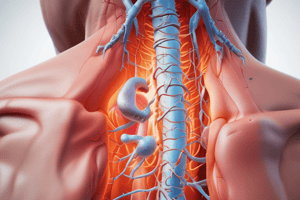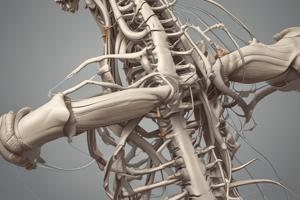Podcast
Questions and Answers
What does lumbar spinal stenosis (LSS) involve?
What does lumbar spinal stenosis (LSS) involve?
- Enlargement of the spinal canal
- Compression of the thoracic spine
- Compression of neural and vascular elements in the lumbar spine (correct)
- Compression of the cervical spine
What is the estimated prevalence of LSS in the general population?
What is the estimated prevalence of LSS in the general population?
- 2%
- 15%
- 25%
- 9% (correct)
What percentage of older people with signs of spinal stenosis remain asymptomatic?
What percentage of older people with signs of spinal stenosis remain asymptomatic?
- 50%
- Less than 10%
- More than 80% (correct)
- Around 30%
Which condition represents 28% of hospitalizations in Australia?
Which condition represents 28% of hospitalizations in Australia?
What is the most frequent indication for spinal surgery in patients older than age 65 years?
What is the most frequent indication for spinal surgery in patients older than age 65 years?
How do the clinical characteristics of spinal stenosis and lumbar radiculopathy differ?
How do the clinical characteristics of spinal stenosis and lumbar radiculopathy differ?
Which condition is characterized by an acute, severe onset of axial back pain and radicular pain?
Which condition is characterized by an acute, severe onset of axial back pain and radicular pain?
What type of bladder dysfunction is associated with cauda equina syndrome?
What type of bladder dysfunction is associated with cauda equina syndrome?
Which condition is characterized by faecal incontinence at the later stage of the disease?
Which condition is characterized by faecal incontinence at the later stage of the disease?
Which condition presents with saddle anaesthesia?
Which condition presents with saddle anaesthesia?
What is the best surgical outcome associated with before surgery for clients with spinal conditions?
What is the best surgical outcome associated with before surgery for clients with spinal conditions?
Which investigation is considered the most reliable and immediate to confirm the cause of Cauda Equina Syndrome?
Which investigation is considered the most reliable and immediate to confirm the cause of Cauda Equina Syndrome?
What type of muscle weakness is associated with Cauda Equina Syndrome?
What type of muscle weakness is associated with Cauda Equina Syndrome?
What is a common symptom seen in lumbar spinal stenosis?
What is a common symptom seen in lumbar spinal stenosis?
Which age group is typically associated with lumbar spinal stenosis?
Which age group is typically associated with lumbar spinal stenosis?
What symptom is commonly relieved by sitting, forward bending, and supine lying in lumbar spinal stenosis?
What symptom is commonly relieved by sitting, forward bending, and supine lying in lumbar spinal stenosis?
What condition can be mistaken for lumbar spinal stenosis but can be ruled out by history of tobacco use and pedal pulses examination?
What condition can be mistaken for lumbar spinal stenosis but can be ruled out by history of tobacco use and pedal pulses examination?
What is a common reason for acquired or degenerative lumbar spinal stenosis?
What is a common reason for acquired or degenerative lumbar spinal stenosis?
Which type of lumbar spinal stenosis involves compression of the nerve root at the intervertebral foramen?
Which type of lumbar spinal stenosis involves compression of the nerve root at the intervertebral foramen?
What is a typical presentation of intermittent neurogenic claudication in lumbar spinal stenosis?
What is a typical presentation of intermittent neurogenic claudication in lumbar spinal stenosis?
'Pseudo claudication' is another name for which symptom related to lumbar spinal stenosis?
'Pseudo claudication' is another name for which symptom related to lumbar spinal stenosis?
What is the primary role of a physiotherapist in identifying Conus medullaris syndrome and Cauda equina syndrome?
What is the primary role of a physiotherapist in identifying Conus medullaris syndrome and Cauda equina syndrome?
Which condition results from damage to neural structures of the spinal cord segment T12 to S5 nerve root?
Which condition results from damage to neural structures of the spinal cord segment T12 to S5 nerve root?
Which management option is considered optional for pain management in clients with lumbar spinal stenosis?
Which management option is considered optional for pain management in clients with lumbar spinal stenosis?
What is a common clinical presentation that can be a precursor to Cauda equina syndrome and Conus medullaris syndrome?
What is a common clinical presentation that can be a precursor to Cauda equina syndrome and Conus medullaris syndrome?
Which surgical management option involves decompressing the spinal canal and foraminal stenosis?
Which surgical management option involves decompressing the spinal canal and foraminal stenosis?
What is a potential outcome if Conus medullaris syndrome or Cauda equina syndrome is not timely managed?
What is a potential outcome if Conus medullaris syndrome or Cauda equina syndrome is not timely managed?
Which disorder involves damage to neural structures of L3 to S5 nerve root?
Which disorder involves damage to neural structures of L3 to S5 nerve root?
What type of therapy is considered as part of conservative management for lumbar spinal stenosis in clients with mild to moderate symptoms?
What type of therapy is considered as part of conservative management for lumbar spinal stenosis in clients with mild to moderate symptoms?
What is the primary purpose of post-operative physiotherapy in clients who have undergone spinal decompression and fusion procedures?
What is the primary purpose of post-operative physiotherapy in clients who have undergone spinal decompression and fusion procedures?
Flashcards are hidden until you start studying




